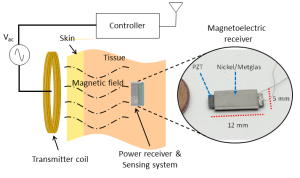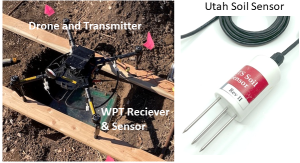Magnetoelectric Wireless Power Transfer

Wireless power transfer (WPT) systems most commonly use two inductively coupled coils. However, in cases where both small size and low frequency are desired, such as transferring power to biomedical implants, magnetoelectric structures can provide a better frequency/size combination. Our magnetoelectric structures are composites of magnetostrictive material (Ni and Metglas), which couples magnetic fields to mechanical strain, and piezoelectric material (PZT), which couples mechanical strain to electric field. Together they convert magnetic fields to voltage. We have developed a WPT system with a self-aligning transmit coil and a self-biased, 5-layer magnetoelectric receiver. This work is funded by the National Science Foundation. You can read more details here, here, here, and here.
Wireless Power Transfer for Smart Agriculture

Together with collaborators at Imperial College London, the University of Aberdeen, Utah State University, and Electrical Engineering at the University of Utah, we have developed a wirelessly powered soil moisture sensing platform. The platform consists of a custom soil moisture sensor (designed by our group), a high power WPT system (designed by Imperial College), a smaller, low power WPT system (designed by Dr. Darrin Young’s group at the University of Utah), and an automatic localization system (designed by us) for the above ground transmitter to be able to find the buried sensor. The transmitter can be mounted to either a drone or irrigations system. The platform enables automated and intelligent management of soil moisture in agriculture. You can read more about this project here, here, and here.

